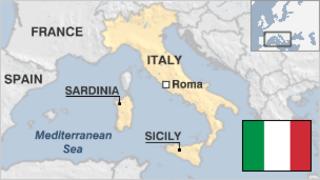Italy country profile
Take the art works of Botticelli, Leonardo da Vinci, Michelangelo, Tintoretto and Caravaggio, the operas of Verdi and Puccini, the cinema of Federico Fellini, add the architecture of Venice, Florence and Rome and you have just a fraction of Italy’s treasures from over the centuries.
While the country is renowned for these and other delights, it is also notorious for its precarious political life, and has had several dozen governments since the end of the Second World War.
The Italian political landscape underwent a seismic shift in the early 1990s when the “mani pulite” (“clean hands”) operation exposed corruption at the highest levels of politics and big business.
Several former prime ministers were implicated and thousands of businessmen and politicians were investigated.
There were high hopes at the time that the scandal would give rise to a radical reform of Italian political culture, but these hopes were dashed when the old structures were replaced by a new political landscape dominated by the multi-millionaire businessman Silvio Berlusconi, who himself became increasingly mired in scandals and corruption affairs.
More recently, populist parties have made the political running, and formed a coalition government in 2018.
FACTS
Italian Republic
Capital: Rome
Population 61 million
Area 301,338 sq km (116,346 sq miles)
Major language Italian
Major religion Christianity
Life expectancy 81 years (men), 86 years (women)
Currency euro
LEADERS
President: Sergio Mattarella
Sergio Mattarella, a constitutional court judge and veteran centre-left politician, was elected president by parliament in 2015 to succeed Giorgio Napolitano, who stepped down due to old age.
He was little known to the general public, but is a respected figure in political circles after a 25-year parliamentary career and several stints as minister in governments of left and right.
Prime minister: Giuseppe Conte
Giuseppe Conte was sworn in in June 2018 as prime minister of Western Europe’s first populist government, whose aim was to cut taxes, boost welfare spending and overhaul European Union rules on budgets and immigration.
Mr Conte, a law professor, was the choice of the far-right League and the radical 5-Star Movement, which formed a governing coalition and ended three months of political deadlock following inconclusive elections.
In August 2019, League leader Matteo Salvini withdrew from the government in the hope of triggering early elections and boosting his party’s position in parliament.
But the 5-Star Movement and centre-left Democratic Party frustrated this plan by agreeing a new coalition without the League, with Giuseppe Conte retaining his position as prime minister.
MEDIA
Italy’s heady blend of politics and media has often made headlines at home and abroad, with concern regularly being expressed over the concentration of media ownership in the hands of one man – former prime minister Silvio Berlusconi.
Mr Berlusconi’s Mediaset empire operates Italy’s top private TV stations, and the public broadcaster, Rai, has traditionally been subject to political influence, so that when Mr Berlusconi was prime minister, he was able to exert tight control over both public and private broadcasting.
Between them, Rai and Mediaset dominate Italy’s TV market and are a potentially powerful political tool, especially as 80% of the population is said to rely on television for its daily news – the highest percentage in the EU.
TIMELINE
1861 – Italy becomes a nation-state under King Victor Emmanuel II.
1915 – Italy enters First World War on the side of the Allies.
1922 – Fascist leader Benito Mussolini forms government, moves country towards fascist dictatorship.
1935 – Italy invades Ethiopia.
1936 – Benito Mussolini forms an alliance with Nazi Germany.
1940-45: Italy fights in Second World War on the German side. Invaded by the Allies in 1943, it signs an armistice. Benito Mussolini is captured and executed by partisans as the war ends.
1948 – New constitution. Christian Democrats win elections.
1951 – Italy joins European Coal and Steel Community, the forerunner of the European Community.
1970s – Italy experiences a decade of political violence from the left and right.
1980s – Economy makes significant advances.
1994 – Media magnate Silvio Berlusconi forms first right-wing government after the “clean hands” scandal sweeps away the previous political elite.
Source: Read Full Article



